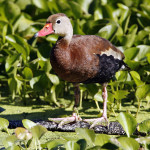• • •
Black-bellied Whistling-Ducks have the long neck and legs of a goose. But their red bill, gray face, cinnamon back and black underbelly make them one of the Texas coast’s most colorful ducks. The other half of their name comes from the sharp whistling sound they make when chatting or flying up.
• Length: 21 inches
• Wingspan: 30 inches
• Season: Year-round
More about Black-bellied Whistling Ducks.
Where they are, and when.
Black-bellied Whistling-Ducks dabble on watery vegetation, eat grains and seeds and occasionally, insects. They gather, feed and perch in flocks. When they’re chicks, they are a puff of downy black and yellow stripes. Juveniles are similar to adults but paler with gray bills.
They usually nest in unlined tree cavities and will adopt nesting boxes when available. Occasionally, they’ll build a shallow bowl of woven grasses on the ground amid thick vegetation where they lay as many as a dozen white eggs.
In the spring, their brood will follow them around in lockstep or swarm in the water behind their parents’ wake.
Black-bellied Whistling-Ducks are relatively rare outside of the woodlands and marshes of southern Texas, but are very common within their range, not just in the wild but even in city parks.
October 9, 2010
A mother Black-Bellied Whistling-Duck took her brood on an outing on the edge of Elm Lake in Brazos Bend State Park. The chicks – fluffy balls of down striped like bees – followed her in a line as she walked along the vegetation and then scattered in all directions once turned loose in the water, much as we did when my mother took us swimming. When mom got too far away, they instinctively assembled into a pack until they found her. After stopping to nibble on vegetation or preen, the mother always took a look around to see that her brood was still with her before moving on.






You must be logged in to post a comment.